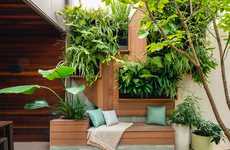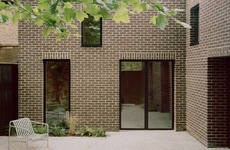
London's Citicape House is Set to Become Europe's Largest Living Wall
Laura McQuarrie — November 11, 2019 — Eco
References: sheppardrobson & dezeen
Sheppard Robson's recently unveiled Citicape House in London is on track to become the "largest living wall in Europe," as it proposes a design that's covered in 400,000 plants. Over the course of a year, the structure's plant-covered facade is said to be able to capture more than eight tons of carbon and produce six tons of oxygen, which will help to improve air quality in the urban center.
The 11-storey Citicape House is planned to replace an existing office building in a heavily trafficked area of London and serve as a precedent for how cities can address pressing issues like climate change and air pollution. The mixed-use building is set to contain a five-star hotel, offices, co-working spaces, event spaces, a bar, spa, restaurant and more.
Image Credit: Sheppard Robson
The 11-storey Citicape House is planned to replace an existing office building in a heavily trafficked area of London and serve as a precedent for how cities can address pressing issues like climate change and air pollution. The mixed-use building is set to contain a five-star hotel, offices, co-working spaces, event spaces, a bar, spa, restaurant and more.
Image Credit: Sheppard Robson
Trend Themes
1. Living-wall Clad Buildings - The trend of incorporating living walls in building design presents opportunities for companies in the architecture and construction industry to explore sustainable and eco-friendly solutions that improve air quality in urban areas.
2. Urban Green Spaces - Creating urban green spaces, like the Citicape House, is a growing trend that offers opportunities for businesses in the landscaping and horticulture industries to provide green design solutions for cities, improving sustainability and well-being.
3. Mixed-use Development - The rise of mixed-use developments, combining commercial and residential spaces, allows for innovative and environmentally conscious designs like Citicape House, opening up opportunities for developers to create sustainable and multifunctional spaces in urban environments.
Industry Implications
1. Architecture and Construction - The architecture and construction industry can capitalize on the trend of incorporating living walls in building design by developing expertise in sustainable materials and green technologies for creating eco-friendly structures.
2. Landscaping and Horticulture - The landscaping and horticulture industry can take advantage of the trend towards urban green spaces by offering services and products that help design, install, and maintain living walls, green roofs, and other sustainable landscaping features.
3. Real Estate and Development - The real estate and development sector can tap into the trend of mixed-use developments by integrating sustainable design elements like the use of living walls, attracting environmentally conscious buyers and tenants.
6.9
Score
Popularity
Activity
Freshness























